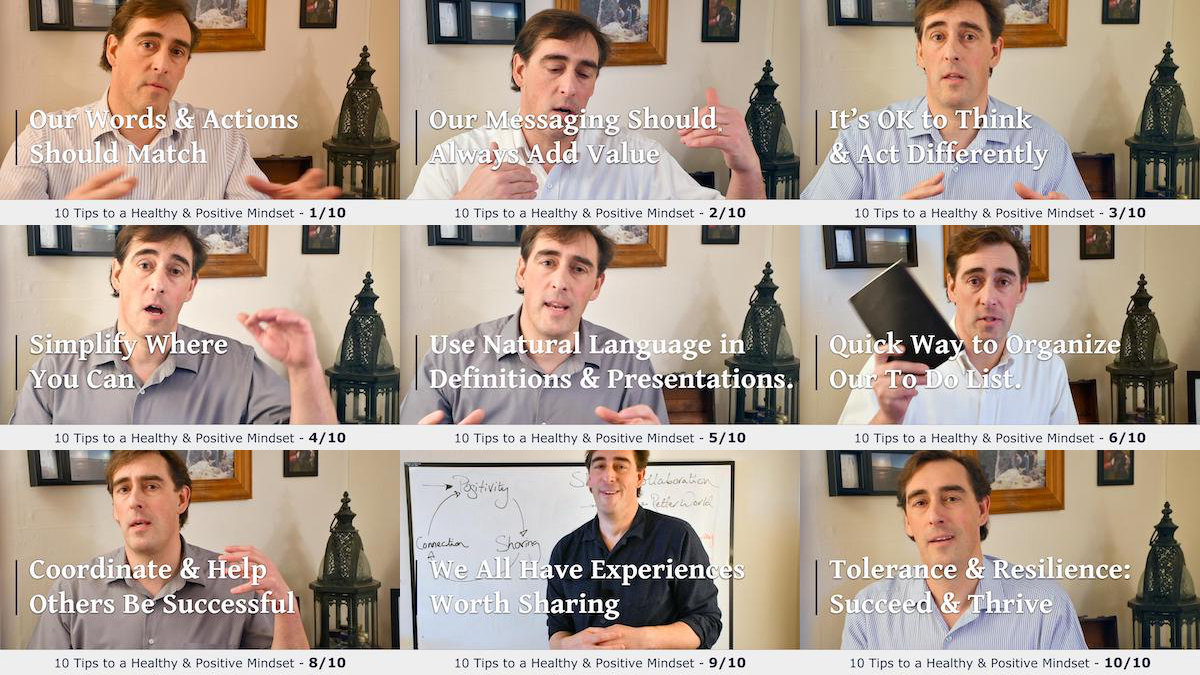There are as many examples of being open-minded as there are people, behaviours, and situations. Minor examples include trying new food or watching a new show, and at the other end of the scale are the giant steps, like deciding to talk and listen to people with opposing political views.
At work, we encounter just as great a variety of open-minded examples. Maybe Steve in IT has switched to eating healthy, having ditched the energy drinks and candy, and is now looking for support, not discouragement – even though you’ve enabled his habits for a while.
What of that new business software you need to learn, even though the old one was adequate? It’s like eating Chicken Vindaloo when you’re more of a Sweet and Sour Pork type of person. It takes effort to try, and some weird faces, but you know what? That curry actually tastes pretty good!
And if you work in Sales but need to talk to Bob in Accounting or Jane in HR, it can feel like talking across the political, social, or even planetary divide.
This guide shares three practical examples of being open-minded and their lessons learned – two from work, one social media based – and highlights some benefits of being open-minded and the pitfalls that keep us closed in our thinking.
Contents
- 3 Practical Examples of Being Open Minded
- Why Be Open-minded?
- Be Thoughtful With New Ideas
- Dogmatic vs Pragmatic
- Recap: The Power of Being Open Minded
3 Practical Examples of Being Open Minded
Open Minded Example #1:
How Studying a Hospital Emergency Room Improved My Software Development Projects

When you look at different industries and their processes, what do you see? Do you see concepts you can take and transpose to your own projects or is there nothing in common?
A few years ago, I took a family member to the hospital emergency room. To help reduce my stress in a scary situation, I spent a lot of time watching the staff and what they were doing and it soon became clear there was a well thought out structure to what was going on.
he nurses, Senior Nurse, and doctor all knew what they and each other needed to do, and importantly, everyone knew what had, or hadn’t been done.
All through the magic of a whiteboard on a wall, and a well-oiled process.
The white board, with its check boxes and items drew my attention – I’m a sucker for things like this. The board showed:
- The names of the key medical staff and patient
- A concise description of the patient’s diagnosis
- The remedy to get the patient healthy
- The specific treatments the remedy required
The emergency room showed me how a high-performing team can function: everyone knew what they needed to do; they knew how to do it; and the steps required to do the work were straightforward and effective.
In short, the team was setup for success.
Here are the three concepts I took from the hospital visit to improve my leadership:
#1 Simplified Processes
The equipment to save someone’s life can be complex and expensive. But the steps to perform the medical miracle are not – as a whole, yes, the steps are complex, but broken down into their simplest forms they become straightforward and easy to do with knowledge and repetition.
Two great examples of the intentional simplicity were the humble whiteboard with its concise information and the easy to reach and clearly labelled tools.
#2 Everybody Understood What They Needed to Do
At no point did I hear the nurses asking if a task needed to be performed or who should do it. It was clear who needed to do what and the status of each required task.
#3 Training
The training required to become a nurse or doctor is long and arduous. For good reason. They are literally holding someone’s life in their hands. Throughout our experience in the emergency room, the high level of competence – no fumbling, no uncertainty, no panic – gave me confidence that we would achieve a positive outcome.
Open Minded Example #2:
Get As Much Feedback As You Can From Your Team

One of the leadership skills my former boss and mentor is very good at, is encouraging people to question his ideas. He wants to know if his solutions make sense and, critically, if they require adjustments to make them workable.
As a senior executive at a large university, he needs to build trust and consensus among a diverse range of employees to achieve his strategic goals. From faculty to admin staff to student bodies, he seeks opinions different from his own.
For me, he is the walking definition of being open-minded.
His starting point is his leadership team and the established culture where we can disagree with him. But that dissension needs to be qualified with facts and reasoned arguments. We can’t just say, “that’s a terrible idea.” We have to explain why and offer alternate solutions.
In all cases, the desired outcome for his ideas stayed the same. What was open to change was how we reached the goal.
It’s like saying we want to travel from Los Angeles in the USA to Paris, France, and see the Eiffel Tower. The destination won’t change, but how we get there is open to discussion.
My boss saw a lot of value in people asking questions. By listening to different opinions, he could discover things he didn’t know he’d missed and to make his idea work the best it could, for as broad a group of people as possible.
Open Minded Example #3:
Have a Pragmatic Approach to Growing Your Social Media Audience

We all know there’s a million-and-one influencers out there, each one telling us something different: how to get your first thousand subscribers on YouTube, what to do on LinkedIn, etc.
If we listened to every single one and acted on what they were telling us, we’d just be bouncing from one idea to another. We’d never settle on a strategy to see if it worked.
To build my presence on social media, I know where I want to go, why I want to get there, I’m comfortable with my style, and I have defined goals I want to achieve.
I have a plan.
But I’m open to learning new ways of executing that plan. Like changing how I come across on camera, improving my video editing, correcting my writing to encourage engagement.
An example of my pragmatic approach is video thumbnails.
The standard YouTube thumbnail is someone pulling an exaggerated expression. That’s not me. At all. But I do like the idea of a face in the thumbnails for my YouTube channel.
You can build visual recognition and a smile invites engagement and the opportunity to build trust. More than anything, you’re looking at a person (or cute animal) and making an eye to eye connection.
The open-minded introvert in me has found a happy balance. “No” to the weird and fake face pulling, “Yes” to the natural smiles that occur when recording.
So, that’s what I do. I find a suitable frame from the video that shows me smiling naturally and use that instead of wasting time trying to fake it and hating the picture, so I re-do and re-do until my fake smile would put my father’s exasperated, angry grimace to shame.

These feel much more authentic and relaxed, like me in real life.
Episode 3 of the Be Helpful Experiment Videocast
Watch the video or scroll down for the rest of the article.
Why Be Open-minded?
Why should you be open-minded? What’s in it for you?
You’re Open to Learning New Things
Your interest in learning new things and see different points of view gives you a growth mindset, which fuels your desire to continue learning and understanding new concepts.
You Create Solutions
This increased pool of knowledge and experiences provides new ideas that others may not have thought of, and the ability to put them into practice. When somebody comes and says, “Can you solve the problem I have?” Yes, yes you can.
Because you’ve listened to the person asking for help, you have a good perspective on their problem, what the solution will look like, and how to deliver that solution.
You can do all those things because you’re open to new ideas, concepts, and ways of doing things. Which builds your reputation of being someone who can work with anybody and everybody. And that’s very much a good thing.
Be Thoughtful With New Ideas

There’s a finite amount of space in our working memories. As new ideas come in, old knowledge flows out. We don’t want to be so open-minded we’re like an open bucket sloshing water everywhere. When we get a new idea, we are thoughtful about it, think through it, and see what the impacts are.
If we embrace a new idea and run with it, are we headed in the right direction? Are we going to be more efficient and proficient? If the answer is yes, then it’s an idea we want to accept and our old way of doing things comes out.
Dogmatic vs Pragmatic
Dogmatic: Follow a set of rules, no matter what.
If we consider ourselves open-minded but maintain a dogmatic approach to life, our focus is still on our identified bias. We’re not open to knowledge, experience, people, and ideas from other areas. That’s going to stunt our career and destroy our reputation.
Pragmatic: Deal with things sensibly and realistically.
When we’re pragmatic, we’re open to many ideas. Even ones that at first view we’re not keen on. That flexible approach builds our reputation for being someone who can work with anybody.
The Joy of Being Pragmatic: Friendly Rivalries
In my days of long hair and shorter responsibilities, I drove a Triumph Spitfire. A nippy little British sports car with a soft top. I loved that car!

Within the British sports car world, there is a longstanding rivalry between Triumph and MG drivers, going back to the road racing days of the 1950s and 60s. When driving down the road and you saw a fellow Triumph Spitfire coming the other direction, or maybe a Herald or Vitesse (other Triumph cars) you’d flash your headlights and give a big hearty wave!
But if it was an MG? You’d pretend to have a scowl!
Yet it was a friendly rivalry. When gathered at car rallies, parked side by side, our appreciation was for a stylish car first, and manufacturer second. If it was a beautiful sports car – as both Triumph and MG produced – it didn’t matter the badge on the grill.
The Danger of Being Dogmatic: Toxic Rivalries
Not all rivalries are friendly, of course. Some can be very toxic. For example, in the early days of mobile there was a huge rivalry between the Apple and Android platforms.
I remember several of my colleagues who believed with an almost zealot like passion in the philosophy behind Google’s Android platform. If they knew you were an Apple user, you couldn’t be friends with them. Unfortunately, this dogmatic attitude made working with them difficult and brought considerable stress and friction to the office.
The Benefits of Being Pragmatic
One of the best compliments I’ve received was from my former boss and mentor, who said I was very pragmatic.
I read a lot and if the book or article holds my attention, I’ll stay with it. If it doesn’t, I’ll ditch it and move on. I’m searching for that Golden Nugget – thanks to my growth mindset and open-minded approach to learning.
When listening to different people and perspectives, the Golden Nugget is the idea that jumps out and makes you snap your fingers and shout, “I really like that! I know what I can do with that!”
Two Books I Like and One I Don’t – An Example of Prospecting for That Golden Nugget
Over the years, I’ve developed a particular approach to managing projects and teams, based on a melting pot of ideas and authors.
Charles Duhigg’s book, The Power of Habit: Why We Do What We Do in Life and Business taught me the power of keystone habits and gave me the inspiration to develop my Be Helpful Keystone Habit – which changed the way I lead projects and build relationships.
Marshall Goldsmith’s book, What Got You Here Won’t Get You There is an excellent book, and what I love about it most is the title. It really tells you all you need to know.
Now, there’s one book people rave about that I just don’t get. That’s Stephen Covey’s Seven Habits of Highly Effective People. I’ll be honest, I didn’t even make it a quarter of the way through before I stopped reading it.
There is one Covey habit I do like though – his idea of scheduling the big rocks. You put the important items on your calendar first, then schedule the smaller, less important activities around them.
Although I didn’t like the book, I didn’t close my mind to Covey’s ideas completely. I found one I liked and now I use it.
Recap: The Power of Being Open Minded
- Having an open-minded encourages a growth mindset and a desire to learn new things.
- You’re an effective problem solver because you relate to different points of view, which enables you to create the right solution that people want to use.
- You work well with everybody and anybody because you are open to different opinions.
- People want to work with you again and again. People consider you to be an exceptional leader.





